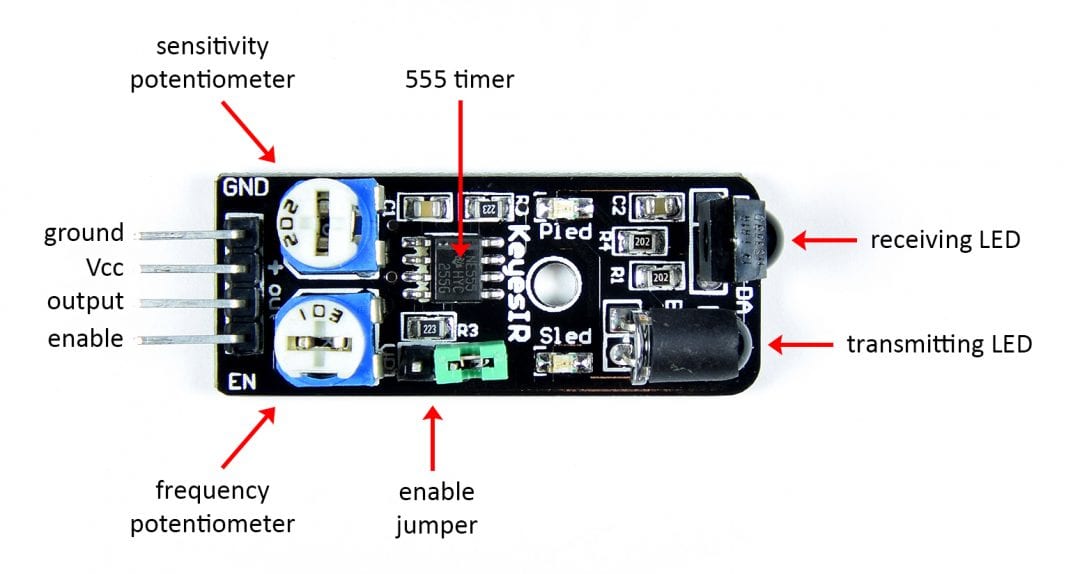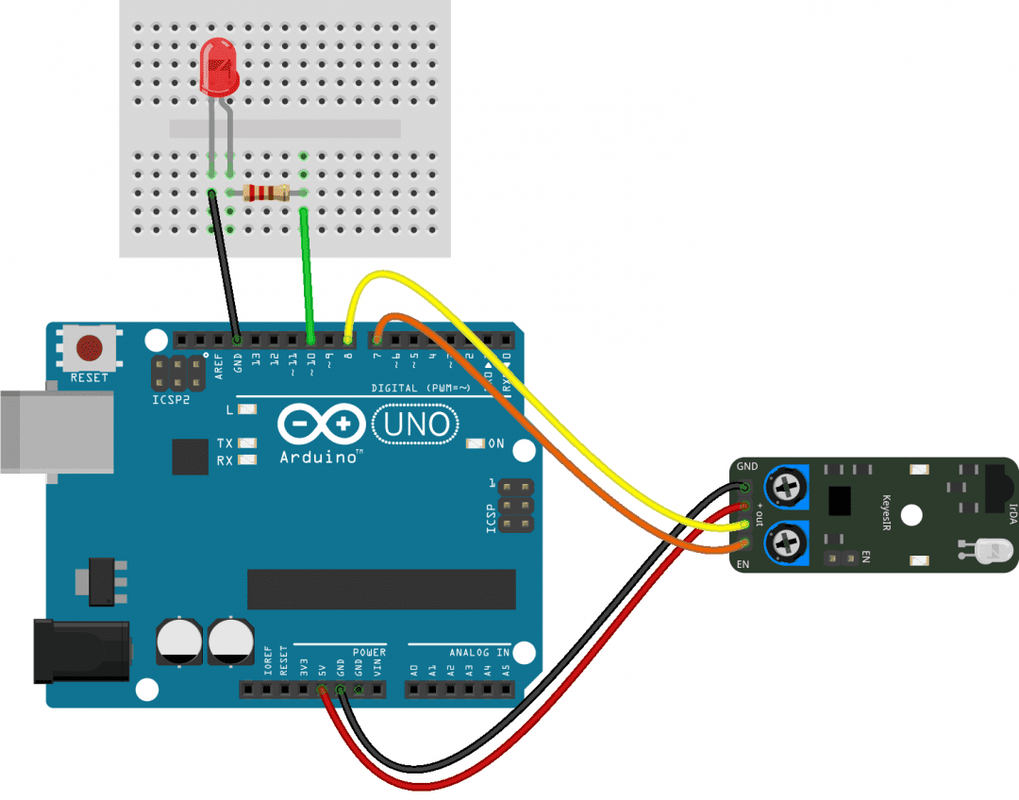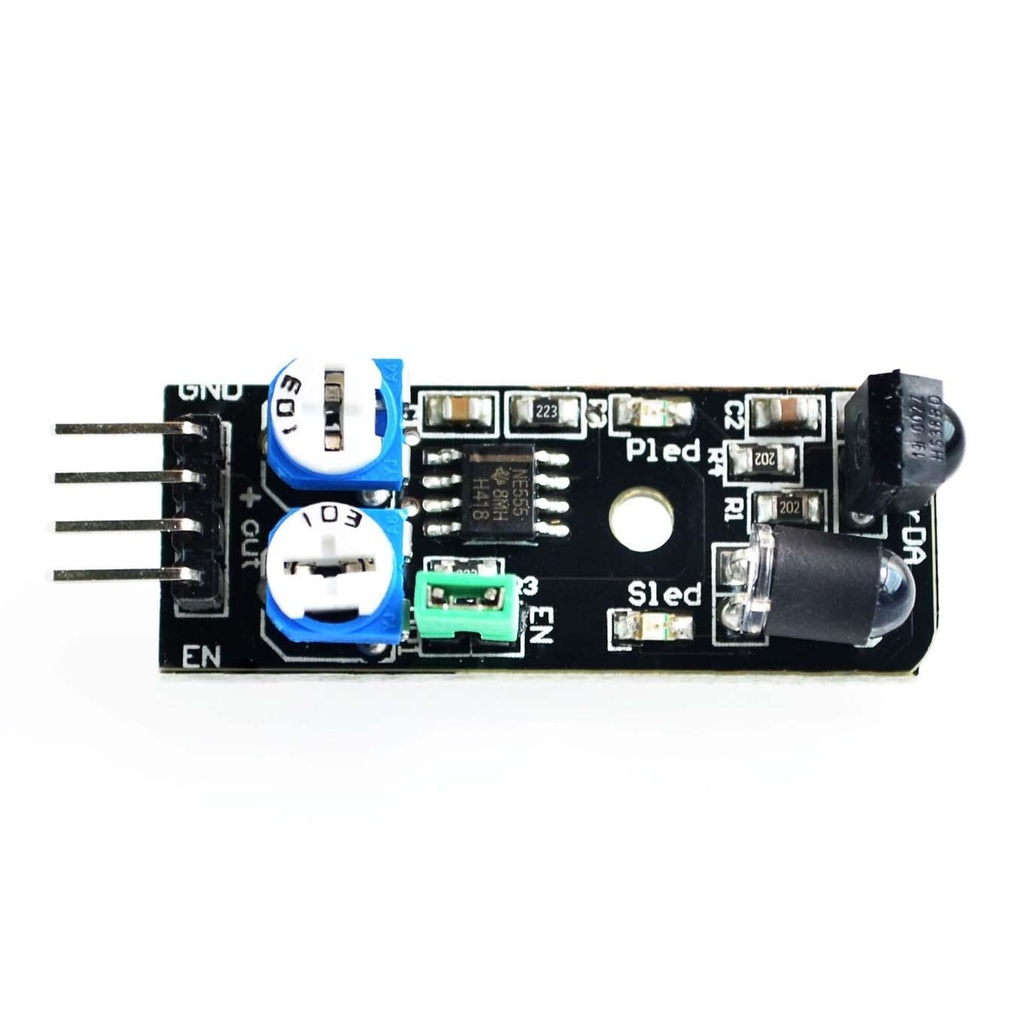Features:
- Distance Adjustable: Detection range from 2cm to 40cm, adjustable via potentiometer.
- Wide Voltage Compatibility: Operates at 3.3V to 5V; works with Arduino, ESP32, ESP8266, Raspberry Pi, etc.
- Ambient Light Adaptability: Performs reliably under varying light conditions.
- Infrared Emitter and Receiver: Uses IR LED and photodiode for reflection-based detection.
- Simple Pin Configuration: 4 pins - GND, + (Vcc), S (Signal), EN (Enable); jumper configurable.
- Distance and Frequency Adjustment: Left knob adjusts range; right knob adjusts IR pulse frequency.
- Low Power Consumption: Operates at 20mA current.
- Temperature Range: -10°C to 50°C operating environment.
- Effective Angle: 35° detection cone.
- Compact Design: 1.6 x 4 cm, weight: 9g.
- TTL Output: LOW signal = obstacle detected; HIGH = no obstacle.
- Multi-turn Resistance: Enables fine-tuning of sensitivity and range.
- IR Pulse Frequency: Operates at 38kHz, compliant with HS0038DB specs.
Principle of Work:
- IR Emission: IR LED emits 38kHz pulses outward.
- Reflection Detection: IR photoreceptor detects reflected light from objects.
- Logic Output: Output is HIGH when no object; LOW when object is detected.
Interaction with Microcontroller (MCU):
- Connections: Connect GND, Vcc, S (Signal) to MCU digital input, and EN to digital output (optional).
- Voltage Supply: 3.3V–6V DC.
- Sensitivity Adjustment: Adjust using onboard trimpots.
- Output Signal: Digital HIGH/LOW.
- Enable Pin: HIGH to enable; LOW to disable. Jumper available for always-on mode.
- Programming: Read digital pin and act accordingly (e.g., turn on LED, stop motor).
Pinout:

| Pin Name |
Description |
Additional Info |
| GND |
Ground (0V) |
Common ground reference |
| + |
Vcc (3.3V–6V) |
Positive power supply |
| S |
Signal Output |
LOW when object detected, HIGH otherwise |
| EN |
Enable Pin |
HIGH = enabled; LOW = disabled |
Applications:
- Obstacle avoidance in robotics
- Line-following robots
- Proximity sensing in sanitizers and faucets
- Security and intrusion detection
- Smart lighting control
- Object counting and positioning in automation
- Gesture recognition
- Automatic door opening
- Interactive displays and kiosks
- DIY electronics and automation projects
Circuit Diagram:

| Component |
Arduino Pin |
Connection |
| IR Sensor - Signal |
Pin 8 |
Connects to digital input |
| IR Sensor - + |
5V |
Vcc power |
| IR Sensor - GND |
GND |
Common ground |
| IR Sensor - EN |
Pin 7 |
Enable control |
| LED - Anode |
Pin 10 |
Output indicator |
| LED - Cathode |
GND |
Via 220Ω resistor |
Library:
No library required.
Example Code:
int sensorPin = 8;
int enablePin = 7;
int ledPin = 10;
void setup() {
pinMode(sensorPin, INPUT);
pinMode(enablePin, OUTPUT);
pinMode(ledPin, OUTPUT);
}
void loop() {
digitalWrite(enablePin, HIGH); // Enable sensor
int val = digitalRead(sensorPin);
if (val == HIGH) {
digitalWrite(ledPin, HIGH); // Obstacle detected
} else {
digitalWrite(ledPin, LOW); // No obstacle
}
}
Technical Details:
- Operating Voltage: 3.3V – 6V DC
- Operating Current: ≥ 20mA
- Detection Range: 2cm to 40cm
- Detection Angle: 35°
- Output: LOW (obstacle), HIGH (clear)
- Sensitivity: Adjustable via trimpot
- Temperature Range: -10°C to +50°C
- Output Signal: TTL level
Resources:
- Fritzing Part: KY-032 IR Sensor Module
- Datasheets: HS0038DB IR Receiver, NE555 Timer
Comparison Table:
| Feature |
IR Obstacle Module |
KY-032 Module |
| Detection Range |
2–20cm |
2–40cm |
| Detection Angle |
35° |
35° |
| Voltage |
3–5V |
3.3–6V |
| Indicator LED |
Yes |
Yes |
| Output |
TTL |
TTL |
| Adjustable Range |
Yes |
Yes (more precise) |
| Module Size |
3.1 x 1.5 cm |
4 x 1.6 cm |
Features:
- Distance Adjustable: Detection range from 2cm to 40cm, adjustable via potentiometer.
- Wide Voltage Compatibility: Operates at 3.3V to 5V; works with Arduino, ESP32, ESP8266, Raspberry Pi, etc.
- Ambient Light Adaptability: Performs reliably under varying light conditions.
- Infrared Emitter and Receiver: Uses IR LED and photodiode for reflection-based detection.
- Simple Pin Configuration: 4 pins - GND, + (Vcc), S (Signal), EN (Enable); jumper configurable.
- Distance and Frequency Adjustment: Left knob adjusts range; right knob adjusts IR pulse frequency.
- Low Power Consumption: Operates at 20mA current.
- Temperature Range: -10°C to 50°C operating environment.
- Effective Angle: 35° detection cone.
- Compact Design: 1.6 x 4 cm, weight: 9g.
- TTL Output: LOW signal = obstacle detected; HIGH = no obstacle.
- Multi-turn Resistance: Enables fine-tuning of sensitivity and range.
- IR Pulse Frequency: Operates at 38kHz, compliant with HS0038DB specs.
Principle of Work:
- IR Emission: IR LED emits 38kHz pulses outward.
- Reflection Detection: IR photoreceptor detects reflected light from objects.
- Logic Output: Output is HIGH when no object; LOW when object is detected.
Interaction with Microcontroller (MCU):
- Connections: Connect GND, Vcc, S (Signal) to MCU digital input, and EN to digital output (optional).
- Voltage Supply: 3.3V–6V DC.
- Sensitivity Adjustment: Adjust using onboard trimpots.
- Output Signal: Digital HIGH/LOW.
- Enable Pin: HIGH to enable; LOW to disable. Jumper available for always-on mode.
- Programming: Read digital pin and act accordingly (e.g., turn on LED, stop motor).
Pinout:

| Pin Name |
Description |
Additional Info |
| GND |
Ground (0V) |
Common ground reference |
| + |
Vcc (3.3V–6V) |
Positive power supply |
| S |
Signal Output |
LOW when object detected, HIGH otherwise |
| EN |
Enable Pin |
HIGH = enabled; LOW = disabled |
Applications:
- Obstacle avoidance in robotics
- Line-following robots
- Proximity sensing in sanitizers and faucets
- Security and intrusion detection
- Smart lighting control
- Object counting and positioning in automation
- Gesture recognition
- Automatic door opening
- Interactive displays and kiosks
- DIY electronics and automation projects
Circuit Diagram:

| Component |
Arduino Pin |
Connection |
| IR Sensor - Signal |
Pin 8 |
Connects to digital input |
| IR Sensor - + |
5V |
Vcc power |
| IR Sensor - GND |
GND |
Common ground |
| IR Sensor - EN |
Pin 7 |
Enable control |
| LED - Anode |
Pin 10 |
Output indicator |
| LED - Cathode |
GND |
Via 220Ω resistor |
Library:
No library required.
Example Code:
int sensorPin = 8;
int enablePin = 7;
int ledPin = 10;
void setup() {
pinMode(sensorPin, INPUT);
pinMode(enablePin, OUTPUT);
pinMode(ledPin, OUTPUT);
}
void loop() {
digitalWrite(enablePin, HIGH); // Enable sensor
int val = digitalRead(sensorPin);
if (val == HIGH) {
digitalWrite(ledPin, HIGH); // Obstacle detected
} else {
digitalWrite(ledPin, LOW); // No obstacle
}
}
Technical Details:
- Operating Voltage: 3.3V – 6V DC
- Operating Current: ≥ 20mA
- Detection Range: 2cm to 40cm
- Detection Angle: 35°
- Output: LOW (obstacle), HIGH (clear)
- Sensitivity: Adjustable via trimpot
- Temperature Range: -10°C to +50°C
- Output Signal: TTL level
Resources:
- Fritzing Part: KY-032 IR Sensor Module
- Datasheets: HS0038DB IR Receiver, NE555 Timer
Comparison Table:
| Feature |
IR Obstacle Module |
KY-032 Module |
| Detection Range |
2–20cm |
2–40cm |
| Detection Angle |
35° |
35° |
| Voltage |
3–5V |
3.3–6V |
| Indicator LED |
Yes |
Yes |
| Output |
TTL |
TTL |
| Adjustable Range |
Yes |
Yes (more precise) |
| Module Size |
3.1 x 1.5 cm |
4 x 1.6 cm |


